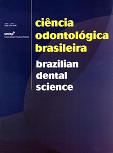Influência de aplicações do laser érbio:yag sobre a viabilidade microbiana
DOI:
https://doi.org/10.14295/bds.2004.v7i1.474Abstract
O objetivo do trabalho foi avaliar, in vitro, a atividade antibacteriana do laser érbio:YAG sobre biofilme formado por cepas Escherichia coli ATCC 8739, Escherichia coli ATCC 25922 e Staphylococcus aureus ATCC 6538 e cepas de Fusobacterium nucleatum isoladas de pacientes com doença periodontal, bem como sobre cepas de Fusobacterium nucleatum em suspensão, inoculadas sobre corpos-de-prova de dentina. Após o cultivo das bactérias em caldo infuso de cérebro e coração, alíquotas de 2.107 cels/ml de cada tubo foram transferidas para cavidades de microplacas, completando seu volume com caldo de tripticaseína de soja acrescido de 1% de glicose e 1‘% de sacarose, o qual foi trocado diariamente. O biofilme foi submetido à ação do laser a 120 mJ, 10 Hz, por 5, 10, 15, 20, 30 e 60s, mantendo distância de 2,5cm da microplaca. Fez-se também a inoculação de 105 cels/ ml de F. nucleatum sobre corpos-de-prova (4mmX 5mm), sendo submetidas à irradiação do laser, nos mesmos parâmetros físicos, por 15s. A avaliação da contaminação residual foi realizada em ágar sangue. Observou-se redução de 93,58% dos microrganismos após 20s de irradiação e a eliminação total após 60 s. Quanto à ação do laser sobre F. nucleatum em suspensão, verificou-se eliminação total do conteúdo séptico. Conclui-se que atividade antibacteriana do laser de érbio:YAG sobre os microrganismos em forma de biofilme pode ser eficaz, em função do tempo de irradiação e dos parâmetros físicos utilizados e que microrganismos em estado planctônico são mais sensíveis ao laser do que em forma de biofilme.
Downloads
Downloads
Published
How to Cite
Issue
Section
License
Brazilian Dental Science uses the Creative Commons (CC-BY 4.0) license, thus preserving the integrity of articles in an open access environment. The journal allows the author to retain publishing rights without restrictions.
=================




























